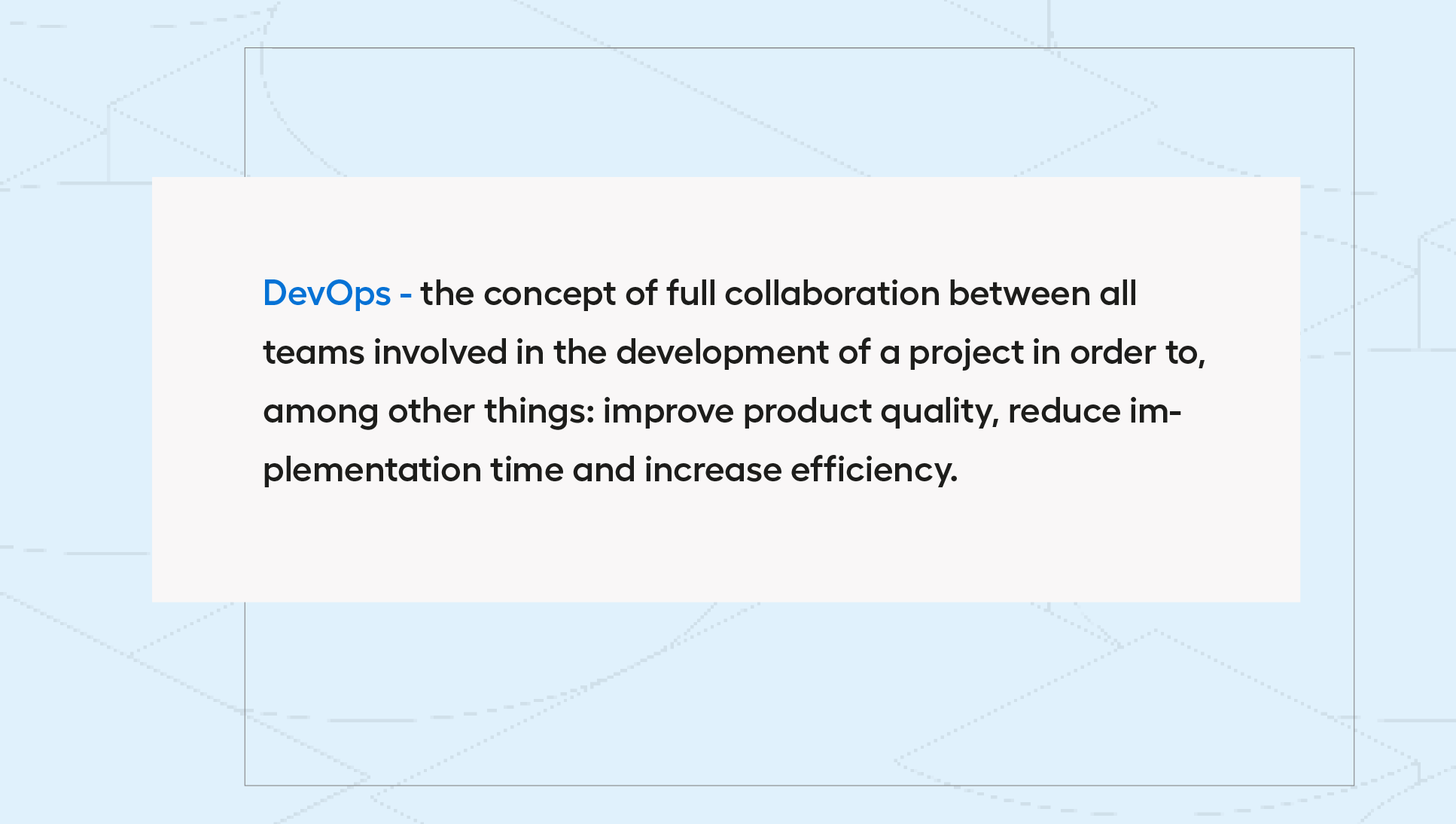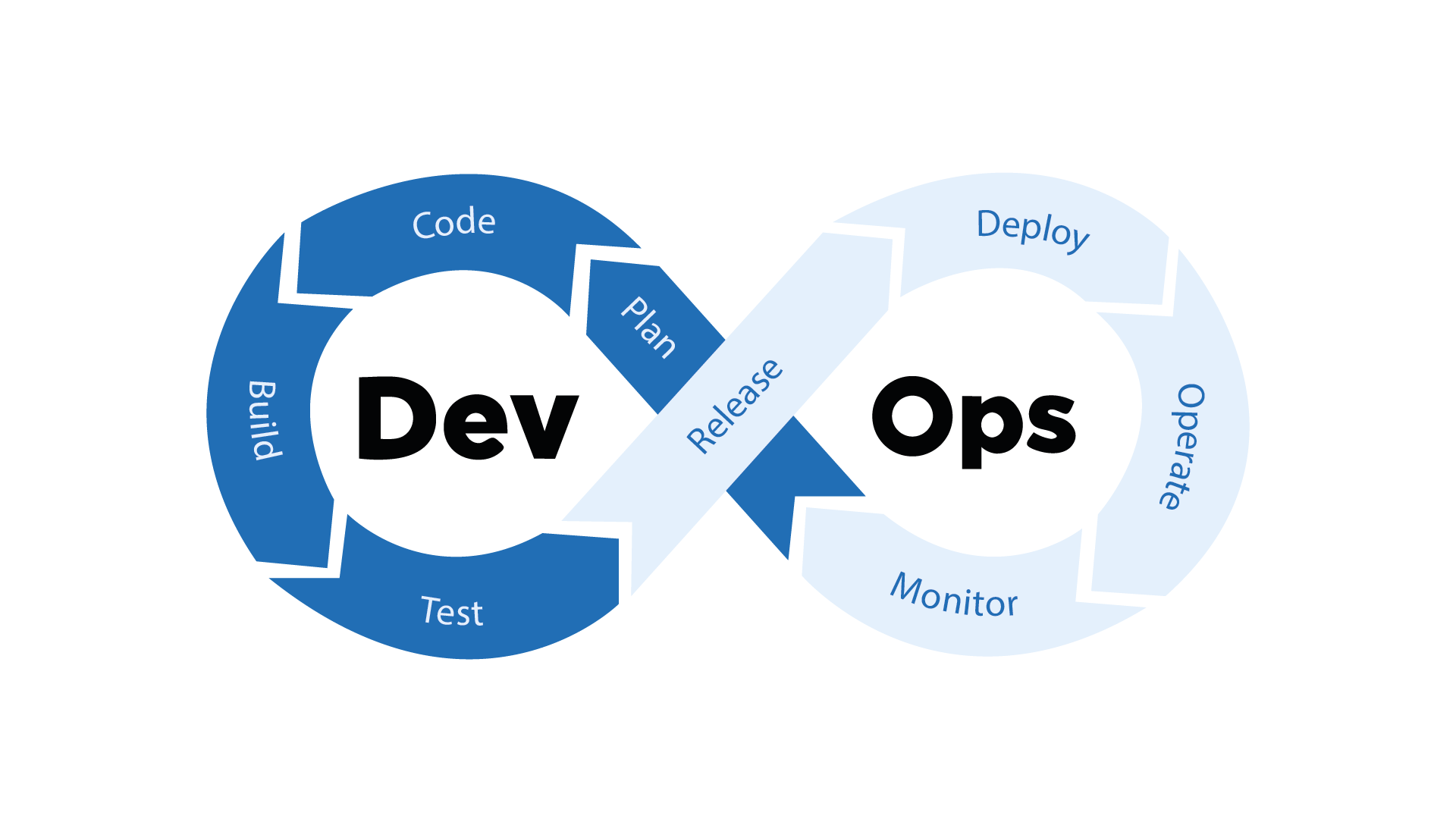From concept to project maintenance - how does the DevOps service model work?
By executing projects sequentially, stage by stage, you must accept that inflexibility and possible delays are inevitable. Failure of one task results in stopping the entire project.This is precisely why such a model of working in IT is now becoming ineffective in view of the increasing complexity of projects. Against this challenge, the DevOps methodology provides an alternative, effectively streamlining project work. It not only eliminates the risk of downtime, but also automates some tasks, thus minimising errors. Most companies working with this methodology have noticed that they are able to deploy code twice as fast (according to statistics from Radix company). Want to learn more about this topic?
Find out how the idea of DevOps can affect efficiency and effective sales in your eCommerce. Learn the details of the work of DevOps engineers and the tools they use. You will read all about it in this article!
What is DevOps?
To get a closer look at the essence of DevOps methodology, it is worth considering at the outset: "what does DevOps actually mean?" The name is a combination of shortened forms of two words - development and operations (programming and administration), the key areas in the creation of a project. This fusion emphasises that the DevOps process implies synergy between all teams working on project development. This means that developers, testers, system administrators and other teams simultaneously work together to:
- reduce software delivery time,
- increase the quality of the project and eliminate possible errors,
- automate the various stages,
- monitor and improve systems on an ongoing basis.
Praktyki DevOps to jednak nie tylko techniczne rozwiązanie wykorzystujące złożony zestaw narzędzi. To także zmiany w kulturze i organizacji pracy, w ramach której wszystkie ogniwa w zespole harmonijnie działają na wszystkich etapach projektu (w odróżnieniu od tradycyjnych metod zarządzania takich jak np. Waterfall, gdzie poszczególne etapy projektu następują po sobie).

The most important goal of DevOps is therefore continuous process improvement. Regular monitoring, data analysis and implementation of innovations allow for continuous improvement in the quality of the project. As a result, online store owners can enjoy not only a more efficient platform, but also a faster response to changing market needs.
Infinite possibilities of DevOps in 4 steps
If you type the term DevOps into a search engine, you're sure to quickly come across graphics depicting the infinity sign. Not without reason - it is this symbol that reflects the idea behind the DevOps model. How to explain it most simply? DevOps collaboration implies the simultaneous work of teams and their intermingling at different stages of the project. Among them can be distinguished 4 major areas, namely: design, implementation, testing and deployment, and maintenance and monitoring. Are you curious about what distinguishes each of them? Find out more, learn about the most popular tools used at each stage, and check out what benefits the use of DevOps methodology brings to the functioning of eCommerce.

STEP 1: Design
Every IT project begins with the creation of a concept. Already at this stage, development and operations teams begin to collaborate on DevOps services - together they define goals, select appropriate technologies and design the architecture. This way of working allows us to organise the work effectively, usually contributing to faster and more efficient project implementation. The most common way to do this is using the kanban technique, where tasks are divided into individual phases (e.g. "to-do", "in progress", "tested" or "completed") and and segregated into one board. This makes it possible to monitor progress, identify delays and coordinate activities.
DevOps methodology not only enables the definition of goals or the choice of technology, but also focuses on tools that support communication and maintain consistency from the very beginning. One of the most popular such systems is Jira, which allows, among other things: project management, creating tasks and tracking their progress, as well as iteration planning (repeating the same operations to minimise the risk of errors). Just as often, teams turn to Confluence, a system for creating, sharing and collaboratively creating project documentation.
STEP 2: Implementation
In the implementation phase, teams join forces, working on code and infrastructure simultaneously. At this stage, DevOps activities are primarily guided by process automation. It is by automating repetitive activities that developers gain time to create new features and reduce mistakes and errors. How to achieve such an effect?
During the implementation phase, DevOps relies on tools to help automate development processes, each with a different function. These include for example:
- Jenkins - allows code to be automatically built and tested after each change, speeding up the software delivery cycle,
- Git - allows developers to collaborate in parallel on different pieces of code. It also collects a history of changes so that individual versions can be controlled.
- Docker - an application containerization platform that allows the isolation of individual units of an environment and their easy portability, making it easier to deploy and scale the platform.
- Ansible - a system that eliminates the problem of managing multiple systems at the same time, allowing you to determine what states should be achieved within your infrastructure configuration.
STEP 3: Testing and implementing the project
The third step is project testing and deployment, where DevOps plays a key role in ensuring the quality and speed of software delivery. The most important thing at this stage is a proper workflow, which in the industry is referred to as CI/CD. What is behind this phrase?
CI/CD stands for Continuous Integration/Continuous Deployment. It is an approach to software lifecycle management that involves continuously integrating changes made to the source code and automatically deploying new versions of the software after each successful integration. As the name suggests, it consists of two parts:
- Continuous Integration (CI) - is a practice where developers regularly merge their source code changes into a common repository. The process is automated and includes running a set of tests to quickly detect any bugs.
- Continuous Deployment (CD) - extends the CI concept by introducing automatic deployment of changes to the production environment after each successful integration. This means that new features and patches are delivered to end users without the need to manually interfere with the deployment process.
In the context of CI/CD activities, the most common tools used are: Jenkins, GitLab, Travis CI or Spinnaker. Each of them is responsible for a wide variety of tasks. They not only enable effective monitoring of the deployment process but also provide an environment for configuration and test management.
STEP 4: Maintenance and monitoring
The assumptions of the DevOps methodology do not end when the platform is implemented. The final step is to continuously monitor the performance of the eCommerce site, which allows to improve the quality of the project. Monitoring tools, such as Prometheus or Grafana, make it possible to track system performance in real time. This assists teams in responding quickly to potential problems, resulting in higher service availability and, consequently, a better shopping experience for end customers. In addition, DevOps services within this step include:
- maintaining high security standards, e.g. by scanning code for potential threats,
- analysing feedback data - tools for analysing so-called logs (e.g. ELK Stack) enables teams to identify areas for improvement, understand user behaviour, and respond quickly to changing market needs.
- innovating - the idea of continuous improvement of the platform prompts the search for innovative solutions and the introduction and testing of them in practice.
Ongoing monitoring of all areas of the platform allows you to maintain the competitiveness of your online store, especially in the face of a rapidly changing market. Thus, it is a guarantee to maintain not only technically correct, but also satisfactory shopping experience. In this way, you can increase conversions (and consequently - sell more) and build a group of regular customers. This is what makes the comprehensive nature of DevOps services crucial to the success of an eCommerce project.
Why are DevOps services crucial to eCommerce development?
According to Puppet's annual report (titled "The State of Platform Engineering Report''), more than 80% of organisations surveyed in 2023 said they were using DevOps to manage their IT projects. Moreover, this percentage could reach as high as 94% next year. The use of DevOps services is becoming not only a strategic choice, but also an essential element that enables companies to maintain a high position in the competitive electronic market. Among the most important areas where the Development&Operations methodology brings invaluable benefits are:
- Reduced time to market - thanks to CI/CD practices and process automation, teams are able to quickly implement projects, introduce new features, and eliminate bugs. All this while avoiding unnecessary delays.
- Increase project efficiency and quality - continuous testing and process automation guarantee a more stable environment, allowing the end customer to enjoy an error-free professional path, which certainly has a positive impact on their satisfaction with the transaction.
- optimization of project maintenance costs - cooperation between all teams guarantees more efficient resources. On the other hand, automation of individual processes avoids costs associated with various operations.
- increase the security of customer data - this is a key issue in eCommerce. DevOps activities focused on maintaining high standards of code security, regularly scanning potential threats and monitoring infrastructure make organisations better prepared to deal with cyberattack threats.
With these benefits, eCommerce store owners can not only better adapt to current trends, but also stay ahead of customer expectations. Implementing DevOps services in eCommerce is therefore a strategic step that has a direct impact on business efficiency, buyer satisfaction and high competitiveness in the market.
DevOps in your eCommerce
If you care about managing your eCommerce project efficiently, you already know that a good decision will be to choose DevOps methodology. With it, you will not only minimise the risk of delays and errors, but also automate a large part of the technical processes in your online store. As a result, you will gain a strategic advantage by implementing new features faster and adapting to the dynamically changing needs of shoppers. Do you want to always stay one step ahead of the competition while creating a secure and friendly environment for your customers? Write us - our team of DevOps engineers is ready to support you in achieving these goals!



